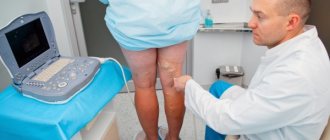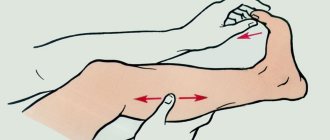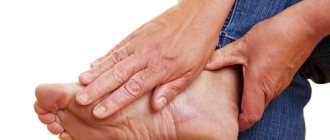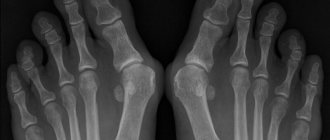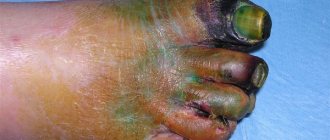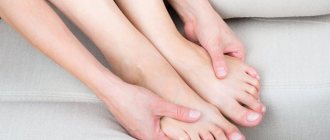With diabetes mellitus, disturbances in the normal blood supply and nervous regulation of the legs are possible, which is predetermined by disruptions in the functioning of the vascular (damage to the arteries of the lower extremities, Mönckeberg's sclerosis) and nervous (neuropathy) systems. The process can be aggravated due to exposure to some kind of infection. These components form the basis of diabetic foot syndrome. A severe course of this disease can result in gangrene and amputation of limbs. Most often, the syndrome develops after 15-20 years of diabetes in 10% of patients, 40-50% of diabetic patients are at risk of losing their legs, up to 90% of patients with diabetic foot have type 2 diabetes.
How does diabetes affect your feet?
People with diabetes are susceptible to developing a variety of leg problems due to long periods of high blood sugar levels. The main ones are diabetic neuropathy and peripheral vascular disease, which have dangerous health consequences.
In medicine, a complex of disorders in the legs of patients with diabetes mellitus is called diabetic foot.
It is characterized by three pathological conditions:
- neuropathy, nerve damage, which manifests itself in loss of skin sensitivity to various irritants (heat, cold, pain, touch, vibration);
- ischemia or circulatory failure, decreased blood flow to the lower extremities;
- a high risk of infection, nerve damage and poor blood circulation reduces the body's resistance to pathogenic pathogens, complicates the healing of tissues in case of damage and the development of an inflammatory process.
The older the patient and the length of the disease, the higher the risk of diabetic foot.
It most often occurs in people who:
- diabetes experience over 25 years;
- there are problems maintaining blood glucose levels close to normal (diabetes in the stage of decompensation);
- high levels of lipids in the blood;
- increased blood pressure;
- have excess body weight.
Diabetic foot is a very dangerous condition for the feet. With it, even a small cut, wound or rubbing of the skin with shoes that is not at all scary for a healthy person can lead to complications. With diabetes, blisters or wounds often appear on the feet, which become easily infected and take a long time to heal.
They form because due to decreased sensitivity a person may:
- not noticing skin irritation in time;
- not feeling a small pebble or other small foreign object in your shoes and walking with it all day;
- not realizing that the shoes he wears are actually uncomfortable and do not match the shape or size of the foot;
- do not feel any squeezing or rubbing of the skin.
Groups at risk for developing VDS
Patients with diabetes experience of more than 10 years- Patients with unstable compensation or decompensation of carbohydrate metabolism (constant fluctuations in glucose levels)
- Smokers
- People suffering from alcoholism
- Patients with stroke
- Having had a heart attack
- Persons with a history of thrombosis
- Patients with severe obesity
Types of disease
Depending on whether the nerves or blood vessels are affected, the following classification of diabetic foot is accepted in medicine:
- Neuropathic. With this type, nerve endings are damaged (polyneuropathy), their sensitivity decreases, and the pain and temperature threshold decreases;
- Ischemic. With this type, vascular damage occurs. Due to the thickening of the walls, the clearance decreases, blood supply and nutrition to the legs decrease. In diabetes, macroangiopathy and microangiopathy develop. With macroangiopathy, large vessels are affected, and the progression of atherosclerosis in the vessels of the heart and lower extremities is accelerated. With microangiopathy, capillaries are damaged;
- Neuroischemic, simultaneous damage to nerves and blood vessels. This type manifests itself as a combination of the previous two.
In practice, neuropathic (66% of cases) and neuroischemic forms are more common.
Risk factors
People at increased risk of developing diabetic foot include:
- Patients who have had extremity ulcers or amputations in the past. If the patient has had ulcers in the foot area in the past, this indicates that he already has certain problems with the blood supply or innervation of the lower extremities. With the addition or progression of diabetes mellitus, existing pathologies may worsen, which will accelerate the development of diabetic foot.
- Patients suffering from peripheral polyneuropathy. This term refers to a pathological condition characterized by damage to various peripheral nerves, most often the nerves of the upper and/or lower extremities. There can be many reasons for the development of this pathology (trauma, intoxication, chronic inflammatory diseases), but all of them ultimately lead to disruption of sensory, motor and trophic functions in the involved areas. The lesion is usually diffuse (widespread) and symmetrical in nature, that is, if one limb is affected, the other can soon be expected to be affected.
- Patients with hypertension (chronic high blood pressure). A chronic increase in blood pressure contributes to more rapid damage to blood vessels by atherosclerotic plaques, which, against the background of diabetes mellitus, can accelerate the development of angiopathy. Patients with high blood cholesterol levels. An increase in the level of “bad” cholesterol in the blood is one of the main factors determining damage to blood vessels in diabetes mellitus.
- Patients who abuse tobacco. It has been scientifically proven that nicotine (found in cigarettes) increases the risk of developing atherosclerosis by increasing cholesterol levels in the blood. At the same time, nicotine directly damages the inner layer of the vascular wall, aggravating the course of atherosclerosis and diabetes.
- Patients aged from 45 to 64 years. Based on many studies, it was concluded that it is in this age group that diabetic foot occurs most often. This is due to the fact that at a younger age, compensatory mechanisms prevent the development of such a formidable complication.
Symptoms
Everyone diagnosed with diabetes has heard the phrase “diabetic foot.” The endocrinologist always warns that this is an insidious disease, asymptomatic, but fraught with dangerous late complications. If you do not keep your sugar level, diabetes inevitably affects the kidneys, eyes, and legs. Unfortunately, not everyone understands how serious these complications are until they are faced with them.
It is very important to know the first symptoms of diabetic foot so that you can take action right away.
At an early stage, only small changes are observed, which many do not pay attention to:
- the skin becomes dry, begins to peel, crack;
- hyperkeratosis appears (thickening, keratinization);
- corns, calluses, ingrown nails form, and nail fungus may develop;
- sensitivity decreases slightly;
- Wounds, cuts, and abrasions take a long time to heal.
In the absence of proper glycemic control and treatment at the initial stage of diabetic foot, the disease progresses rapidly.
The signs of diabetic neuropathy depend on which nerves are affected. In some patients, nerve damage does not cause symptoms.
Others get:
- numbness, feeling of chilliness;
- burning, tingling;
- pain in the feet, legs, toes, hands;
- redness of the skin of the feet;
- increased sweating of the feet;
- reduction in the volume of the lower leg muscles;
- loss of temperature sensitivity.
When large nerve fibers are damaged, there is no sensitivity to finger movements, problems with maintaining balance, and pathological changes in the joints appear.
The following symptoms indicate impaired blood flow to the lower extremities with “diabetic foot”:
- the skin becomes pale and cool to the touch;
- swelling appears;
- toes become bluish;
- hair growth on the legs decreases;
- legs get tired quickly after walking for a short time;
- I am bothered by cramps in the calf muscles.
Neuropathy
Neuropathy - damage to sensory nerves occurs in 70% of patients with diabetes. Nerves in the legs are particularly susceptible to damage because poor diet and high sugar levels destroy the myelin sheath. In the neuropathic form, where a diabetic patient loses sensation in the legs, any microtrauma may go unnoticed until serious ulcers develop.
Signs of foot neuropathy:
- Numbness of the skin
- Tingling
- Pain or burning of the skin of the legs (some forms of neuropathy may cause pain)
How to determine the severity of foot damage?
People with “diabetic foot” need to undergo a full examination at least once a year, which includes an assessment of the condition of their feet. Early diagnosis is very important for timely treatment of identified problems. Consultation with a neurologist, surgeon, vascular surgeon, or podiatrist is necessary. Leg disorders most often develop slowly. It is important to evaluate the condition over time in order to identify minimal deviations at the initial stage.
The podiatrist checks the condition of the skin of the feet, the presence of calluses, and areas of hyperkeratosis. Checks feet for fungal infections, cracks, and foot deformities. If necessary, treats feet and prescribes treatment.
Assessment of vascular condition
The vascular surgeon assesses the condition of the skin of the legs, feels their pulsation, and measures the pressure on the popliteal and femoral arteries. For a more detailed analysis of blood flow in the legs, rheovasography and Dopplerography of the vessels of the lower extremities are prescribed. These methods make it possible to determine the speed and nature of blood movement, the condition of the vascular walls, vascular patency, the intensity and volume of blood flow.
Sensitivity assessment
The neurologist checks reflexes with a neurological hammer, temperature, tactile, pain, and vibration sensitivity of the legs.
The doctor checks tactile sensitivity using a simple monofilament test. Monofilament is a piece of nylon thread weighing 10 g, secured in a convenient holder. During diagnosis, it is placed so that it is located perpendicular to the skin. In this case, at the moment of contact, the monofilament should reach a bent state. The doctor touches certain points on the plantar part of the foot for 1.5 seconds, and then asks the patient about the sensations. If a person does not feel pressure when touching the monofilament, then sensitivity is weakened. And such a patient belongs to the risk group for developing foot wounds.
Vibration sensitivity in diabetic feet is analyzed using a graduated tuning fork with a frequency of 128 Hz. After installing its leg on a certain area of the leg or foot, the duration of the patient’s sensation of vibrations is assessed.
Pain sensitivity is tested by applying tingling stimulation with a needle.
Temperature sensitivity is determined by a “Tip-therm” tester, one end of which is made of plastic and the other of metal. The doctor alternately touches the big toe, dorsum of the foot, inner ankle, and skin of the lower leg with metal (cold) and plastic (warm) surfaces. Normally, the patient should feel the touch of these materials differently.
Self check
To independently assess the sensitivity of your feet to touch, you can use a feather or a piece of cotton wool. It’s easy to run it along the sole of your foot and analyze your sensations. Temperature sensitivity can be checked by touching hot or cold water first with your hand and then with your foot and comparing the sensations. Normally they should be the same. If you feel that the water is hot with your hand, but not with your foot. This may indicate a loss of the ability to sense temperature.
Self-diagnosis does not provide an objective assessment of the situation, so it is better to see a doctor and undergo standard tests.
Diagnostics
In principle, to make this diagnosis, it may be sufficient to examine the foot of a patient with diabetes and detect the characteristic changes described above. However, to clarify the diagnosis, the patient is usually prescribed additional examination methods and consultations with specialists.
When making a diagnosis, as well as at each subsequent examination, the patient is prescribed:
- determination of glycemic profile and glycosylated hemoglobin;
- determination of blood lipid levels (LDL, HDL, cholesterol, triglycerides);
- ankle-brachial index measurement;
- consultation with an endocrinologist;
- consultation with a surgeon (with assessment of neurological deficit and measurement of vibration sensitivity threshold);
- consultation with a neurologist;
- consultation with an ophthalmologist (with a mandatory examination of the fundus to identify vascular pathology).
Patients with severe foot deformities are prescribed x-rays of the feet followed by consultation with an orthopedist.
Patients with absence of pulses in the peripheral arteries of the feet or clinical signs of intermittent claudication undergo Doppler ultrasound and color duplex mapping of the arteries of the lower extremities, followed by consultation with a vascular surgeon.
Patients with existing ulcers in the foot area undergo a culture of wound discharge, followed by determination of the sensitivity of the culture to antibiotics; in the case of deep ulcers, radiography of the feet.
Complications of diabetic foot
Impaired blood circulation and metabolic processes prevent the supply of oxygen and nutrients to the tissues of the leg and foot, and complicate the removal of metabolic products. Local immunity and resistance to infections decreases. Trophic changes occur.
Complications of diabetic foot can be very sad, including the loss of a limb to save life. According to statistics, this happens in 20% of patients.
Complications that develop against the background of damage to nerves and blood vessels include:
- skin and bone infections;
- deformation of the joints and bones of the foot;
- ulcers;
- gangrene.
Infections
Even a slight violation of the integrity of the skin on the lower leg or foot with uncontrolled diabetes mellitus can lead to infection. High blood sugar levels, poor blood supply, and decreased immunity create favorable conditions for the development and proliferation of pathogenic microflora. If a person with diabetic foot is injured, cut, scratched, or rubbed his foot, he needs to treat the damaged surface with an antiseptic as soon as possible and monitor it. If healing does not occur and the condition worsens, you should see a doctor.
The fact is that an untreated superficial foot infection poses a potential threat to the entire limb. It easily spreads in depth and breadth, affecting neighboring tissues. The more advanced the condition, the more difficult it will be to cope with it.
Diabetes mellitus increases the risk of developing osteomyelitis, a severe infection of the bones of the foot.
Fungal infections of the nails (onychomycosis) and skin of the feet are much more common in people with diabetes. Nails infected with fungus become thick, discolored, yellowish-brown, and lose their transparency. They easily break, erode, and separate from the nail bed, which can cause wounds.
Foot deformities
Damage to the nerves in diabetes weakens muscle tone, reduces their motor activity, and gradually causes atrophy. This leads to deformation of the foot, changes in support points, incorrect distribution of body weight, and gait disturbance. Longitudinal and transverse flat feet develop, and the ankle joint changes. The toes take on a hammer-shaped appearance, and the metatarsal heads may protrude. Areas of hyperkeratosis form on the protrusions.
Severe foot deformities in diabetes mellitus include Charcot arthropathy. This is a rare complication that causes weakening of the bones. It is characterized by dislocations, fractures of bones and joints with the formation of an unstable foot, full support on which becomes impossible.
Ulcers
Trophic ulcers are a dangerous complication of diabetic foot. The reason for their development can be small scratches, cuts, or scuffs of shoes. If not treated in a timely manner, deep wounds do not heal for a long time, leading to suppuration, tissue necrosis, and reaching the bone. They most often form on the ball of the foot or the bottom of the big toe. According to statistics, such ulcers occur in 20% of people with diabetes.
At the initial stage of ulcers, small watery blisters appear on the skin, in place of which a wound then forms, which gradually increases in size. Swelling, irritation, and an unpleasant odor may also occur. Sometimes timely diagnosis of ulcers is difficult; symptoms do not appear until infection occurs.
According to statistics, more than 50% of ulcers are complicated by infection. You can see what a diabetic foot with complications looks like on the Internet. Looking at such photos is enough to understand how dangerous they are. Neglecting ulcers can lead to infections, which in turn can lead to limb loss.
Very often, for people who do not yet know that they have diabetes, a long-term non-healing ulcer on the leg becomes the reason for visiting a doctor, and is regarded as the first sign by which a person is diagnosed with this diagnosis.
Gangrene
Gangrene is necrosis (death) of tissues of a living organism. The main reason for its development is tissue ischemia caused by insufficient blood supply. The first signs of gangrene: areas of necrosis, blackening of the skin, trophic ulcers.
Treatment of gangrene is very difficult and in most cases leads to disability. To save a person's life, doctors have to amputate the affected part of the limb or the entire limb so that the infection does not spread to the entire body. If the disease is suspected at an early stage, the leg can be saved only if blood circulation in the legs is restored through vascular surgery.
Frequently asked questions for an endocrinologist
Is it true that diabetic foot formation is impossible with type 1 diabetes?
No, the risk of developing DDS depends only on the duration of diabetes. It is more difficult to control glucose levels in type 1 diabetes, which is why complications often develop.
I have been suffering from diabetes for 12 years. Recently a wound appeared on my big toe. After treatment with lotions and Vishnevsky ointment, liquid began to ooze from the wound. I don’t feel pain, can I postpone visiting the doctor?
Using ointments that do not allow air to pass through is a big mistake. Due to this, the wound on your leg has become infected, so a visit to the doctor cannot be postponed!
Six months ago, she underwent amputation of her left foot due to the ischemic form of DFS. A week ago, the stump became swollen and cyanotic. What does this mean and what should be done?
There are 2 options: relapse of circulatory problems and infection of the stump. Urgent consultation with a surgeon is necessary!
Do you need orthopedic shoes for diabetes?
If there is no damage to the feet or they recover quickly, it is enough to wear very comfortable regular shoes. If trophic ulcers often bother you, and the bones and joints of the foot are deformed, then you cannot do without special orthopedic shoes.
Can a person with type 2 diabetes take hot baths?
It is undesirable to take hot baths due to the risk of burns or overheating of the limb, which will lead to the development of diabetic foot.
Treatment
The most effective treatment for diabetic foot is preventative. It will help protect your legs from developing severe complications. The main task is frequent monitoring and correction of glucose levels with sugar-lowering drugs or insulin. To check your blood sugar at home, it is convenient to use a glucometer.
If signs of diabetic foot appear (numbness, pain, burning, pallor, coldness), you should immediately consult a doctor. Among the drugs, medications can be prescribed to treat neuropathy, drugs that improve blood circulation, metabolic processes, and physiotherapy.
If it comes to ulcers and purulent complications, then how to treat diabetic foot depends on the degree and depth of tissue damage. To make sure that the bone is not infected, the doctor orders an x-ray. If detected early, leg ulcers can be treated. For treatment, infected tissues and dead particles are cleaned, and infected tissue is collected for a culture tank to identify the type of pathogen and determine its resistance to antibiotics.
Antibiotics are used in the form of ointments or injections. Dressings are also prescribed to keep the wound clean and dry, and medications that accelerate tissue healing and relieve pain. Until the ulcer heals, the person is advised to unload the foot, rest and a gentle regime. Do not put any weight on your sore leg, as the pressure from walking will aggravate the infection and expand the ulcer. To protect the wound surface, the doctor may prescribe special shoes and gauze bandages.
If the ulcer does not heal for a long time and there are signs of circulatory disorders, a consultation with a vascular surgeon is indicated to resolve the issue of revascularization. Restoring adequate arterial blood supply is necessary for wound healing and eliminating foci of infection. For this purpose, bypass surgery, stenting, and angioplasty are used.
Infections that cannot be treated may require amputation.
Stages of development
The Wagner classification of diabetic foot is popular. She identifies 5 (actually 6) stages of this disease:
- 0 - bone deformity, pre-ulcerative lesion;
- 1 - superficial ulcer - the skin is damaged, but the subcutaneous tissue and muscles are not yet involved;
- 2 - deep ulcer - tendons, bones and joints are visible in the wound;
- 3 - osteomyelitis - necrosis of bone, bone marrow and surrounding soft tissues, with the formation of a large amount of pus;
- 4 - gangrene, visual blackening of a small area of the foot;
- 5 - gangrene spreads along the foot, urgent amputation is necessary to save the patient’s life.
The diagnosis may also contain additional information. In particular, polyneuropathy is a diabetic lesion of nerve fibers. Due to the loss of nerve sensitivity, a diabetic does not notice the injuries and damage to the legs that he receives while walking. If the wounds are not treated, then microbes multiply in them and soon it comes to gangrene.
Features of diabetic foot care
Decompensated diabetes leads to serious foot problems, but these can be prevented or at least minimized. According to statistics, up to 85% of all amputations due to diabetic foot can be successfully prevented. To do this, you need to constantly monitor and maintain normal blood sugar levels, properly care for your feet, and regularly check their condition yourself and with specialized doctors.
Hygiene
If you have diabetic feet, it is very important to keep your feet clean by washing them daily. To do this, use soap and warm water with a temperature around 33 – 35 °C. To check if the water is not hot before swimming, test it with your elbow first. When washing your feet, be careful, do not make sudden movements, use a soft washcloth or sponge. To remove rough skin, gently rub areas where calluses form with a fine-grained pumice stone. After washing, dry your skin and pat it dry with a towel. Pay special attention to the area between your fingers. For convenience, absorb any remaining moisture with a paper towel.
After bathing, apply a moisturizing cream or lotion to the skin of your feet to avoid dryness, flaking, irritation and cracking, and make the skin soft and smooth. The cream should have the most natural composition without chemical flavors and dyes. Avoid applying moisturizer between your fingers. Excess moisture there can cause a fungal infection. To keep the area between your toes dry, treat it with talcum powder or cornstarch.
Pedicure
The best procedure to tidy up your nails and skin is considered to be a hardware medical pedicure for diabetic feet. It will relieve calluses, corns, nail fungus and other problems without injuring thin, easily wounded skin. This procedure should be performed in centers where there is a podiatrist.
Never treat calluses yourself. When the nerves in the feet are damaged, calluses can eventually turn into ulcers. Contact a podiatrist who will remove them safely and advise you on how to prevent these formations in the future and how to take care of your feet yourself.
How to take care of diabetic feet yourself? At home, you can only carefully trim your nails in a straight line. Do not round the edges of the nail plate, as this leads to ingrown nails. After trimming, smooth the sharp ends with a nail file. If you have any problems with your nails, contact your podiatrist immediately.
Inspection
If you have diabetic foot, you need to examine your feet every day. This will help you detect problems at an early stage and take immediate action. Carry out the examination at the same time so that this activity becomes a habit. For example, every evening before going to bed.
Check availability:
- cuts;
- blisters;
- cracks;
- redness;
- swelling;
- calluses, warts;
- ingrown nails;
- changes in color or deformation of the nail plate.
For ease of inspection, use a magnifying mirror. If you can’t carefully examine your feet yourself, ask your loved ones for help. If you notice anything suspicious, contact your doctor immediately.
Shoes and socks
If you have diabetic feet, it is important to choose the right shoes and socks. Don't walk barefoot, even at home. Always wear socks or slippers, because at any moment there is a risk of stepping on something with your bare foot, getting a scratch or a cut. If your feet get cold at night, wear socks at night. To warm your feet, do not use a heating pad, only warm socks. Due to decreased sensitivity in the feet, there is a risk of getting burned.
Change your socks daily to keep them clean and dry. It is better to buy special medical socks for diabetics. They are made of natural soft materials that do not cause irritation. They do not squeeze the leg above the ankle, fit loosely around the calves, eliminate unpleasant odor, and wick away moisture well.
If your feet are cold, it is recommended to wear socks all the time.
If you have diabetic feet, your feet should always be kept warm and dry. Choose high-quality shoes so that they do not get wet in the rain and do not freeze in winter.
Shoes should be comfortable, provide reliable support and shock absorption for the heel and arches of the feet. Avoid tight shoes, high heels, and narrow-toed shoes that pinch your toes.
To choose shoes that will fit exactly, consult a podiatrist. The doctor will give his recommendations taking into account the anatomical features of your foot. If your feet have changed shape, such as Charcot foot, special orthopedic boots or shoe inserts are recommended. You may also need orthotic inserts if you have calluses, bunions, or hammertoes.
Buy new shoes at the end of the day, when your feet are at their largest size. This will ensure the best fit for your shoes.
Before putting on shoes, always check that there are no small pebbles or other foreign objects. If your feet sweat a lot, use antiperspirants or talcum powder before putting on shoes to keep your feet dry. Remember that excess moisture promotes the development of fungal and bacterial infections.
Another point in preventive treatment is proper unloading and shock absorption of the foot. For this purpose, comfortable shoes and special insoles are prescribed. They reduce pressure on the feet, prevent the formation of corns, the appearance of chafing, and ulcerations.
Requirements for shoes for diabetic feet:
- wide square toe;
- thick sole;
- natural breathable materials;
- lightness, softness, flexibility;
- no rough seams that can rub the skin.
If you have had ulcers on the bottom of your feet, you may need special shoes after they heal. Scar tissue under a healed wound is easily injured. It is important to protect her to prevent relapse. Special shoes will allow you to redistribute the pressure under the foot, reduce the load in the area of the former ulcer, transfer it to areas with intact skin, and increase shock absorption under the sole in places of overload.
Folk remedies
Treating diabetic foot at home can also be done. But for this, certain conditions must be met: constant monitoring by a specialist is required, the stage of development of the syndrome should in no case be associated with complications. It is in this case that it will be truly acceptable to be treated with folk remedies.
The following products and compositions can be used:
- Burdock or burdock leaves will also help cope with diabetic foot. They are equally effective both fresh and dried. The active components in the leaves allow you to obtain a powerful tonic and wound-healing effect. It is best to make lotions or compresses from them - apply a leaf to the wound several times a day. You can also make a decoction of 1 teaspoon of dry mixture per 250 grams of water. The resulting decoction will help normalize lymph flow and remove excess fluid from the body.
- Blueberries are a unique berry that can quickly bring blood sugar levels back to normal. The antioxidants it contains help improve blood flow and restore metabolism. Try to eat a glass of this berry every day during each meal. In winter, you can use frozen berries or brew dried leaves.
- You can also cure diabetic foot with regular kefir. This dairy product contains unique bacteria that penetrate the skin, soften it and accelerate the healing process. To achieve a better effect, it is recommended to sprinkle the surface treated with kefir with dried pine needles. This will help protect your skin from fungal infections.
- Clove oil is a unique remedy that is a storehouse of useful substances. It helps to quickly heal wounds, kill all pathogenic microorganisms, and also restore natural blood circulation. If you regularly treat your ulcers with it, they will heal quickly and stop causing you any discomfort.
- A decoction of chamomile, nettle, oak bark and burdock will help restore trophism in the limbs. To prepare it, take all these components in equal proportions and mix thoroughly. After this, take 3 tablespoons of the herb per 1 liter of boiling water and leave to steep for about 2-3 hours. Make lotions from the resulting decoction; you can use it to treat your feet.
What should you not do with your feet if you have diabetes?
When caring for your feet if you have diabetes, you should not:
- cut nails with rounded edges, only in a straight line;
- trim the cuticle, as this is fraught with inflammation, you can carefully move it aside;
- take hot or cold foot baths;
- rub wet feet with a towel;
- walk barefoot to avoid injuring your feet and getting an infection;
- use products to soften calluses, try to remove them with anti-callus patches or sharp instruments;
- use cutting objects for pedicure;
- smear damaged skin on the legs (scratches, cuts, abrasions) with products containing alcohol (iodine, brilliant green); instead, use aqueous solutions of antiseptics (Chlogexidine, Furacilin, Dioxidin).
Recommendations for patients
Basic recommendations for patients contain answers to the following questions:
What not to do?
- do not walk barefoot, especially on the street, in public places;
- do not steam your feet, do not wash them with hot water;
- do not use heating pads;
- do not do salt baths;
- do not use ointment dressings without a doctor’s prescription;
- do not use products to soften calluses;
- do not use other people’s socks, shoes, or visit a public bathhouse;
- do not come close to open fire and heating devices;
- do not treat your feet or cut your nails yourself if your eyesight is poor;
- do not self-medicate. Do not treat calluses, abrasions, corns, hyperkeratoses, or cracks on your own.
When to contact a specialist?
- with the development of an ingrown nail;
- for bruises, abrasions, burns;
- with darkening of the fingers, pain in the calves when walking and at rest;
- loss of sensation in the feet;
- for wounds of any size and any reason;
- for ulcers and suppurations;
- when the deadline prescribed by the diabetic foot department doctor has come, or any questions regarding the feet have arisen.
What should you always do?
- strictly monitor blood glucose levels, consult your endocrinologist in time;
- stop smoking;
- wear cotton or wool socks (not synthetic), loose leather shoes;
- do foot exercises every day, walk for at least 2 hours;
- Treat fungal nail infections (darkening, splitting of the nail) with a dermatologist;
- be examined at least once a year (and if there are changes - once a month) in the diabetic foot department.
What to do every evening?
- carefully examine your feet, using a mirror to examine hard-to-reach areas (if your eyesight is poor, you should use the help of your family);
- wash your feet with warm (never hot) water with baby soap or a slightly pink solution of potassium permanganate;
- thoroughly dry the skin with a personal towel, especially the spaces between the fingers (blot, do not rub);
- lubricate the skin with a thin layer of softening (vitaminized, bactericidal) cream;
- treat the interdigital spaces with vodka;
- if necessary, cut your nails very carefully, leaving them not very short, cutting the nail straight (if you have poor eyesight, cutting your nails yourself is prohibited).
How to improve blood circulation in the legs?
To prevent diabetic foot complications, it is important to maintain good blood circulation in the extremities.
To do this, do leg exercises daily and maintain general physical activity:
- wiggle your toes throughout the day;
- make movements in the ankle joints, pull the toe away from you and towards you, rotate clockwise and counterclockwise;
- Walk more, swim, ride a bike, if there are no contraindications.
If you have a sedentary job, try to get up and walk around a little every hour. While you are sitting, keep your legs in a position that does not impede blood circulation. To do this, space them out slightly. At the same time, your feet should be completely on the floor, wiggle your toes. If possible, elevate your legs, for example by placing them on a stool. Never sit cross-legged for long periods of time. This way you compress the vessels and further reduce blood flow to the feet.
Smoking poses a major threat to your feet. If you suffer from this bad habit, be sure to quit. If you can’t quit on your own, seek professional help from a psychologist. Smoking has a bad effect on the entire cardiovascular system, reduces blood flow to the legs, and contributes to clogged arteries. Accelerates damage to small blood vessels in the feet and legs. Statistically, many people with diabetes who need amputation are smokers.
How to choose the right shoes?
Many diabetic foot symptoms can be avoided by following the rules for choosing shoes for diabetes:
- To choose the right shoe size, you should buy it only in the evening (neither in the morning nor during the day), since it is at this time that the foot reaches its maximum size, which can increase or decrease by several centimeters, and with a diabetic foot, every centimeter matters role in comfortable wearing of shoes.
- Purchased shoes should not need to be broken in. That is, when trying on in a store, a person should immediately feel as comfortable as possible in the shoes.
- It is strictly not recommended to buy shoes with a pointed toe - the toes in the shoes should have enough space.
- When buying shoes, it is best to give preference to orthopedic models. They do not always look aesthetically pleasing, but they are a guarantee that no damage to the legs will occur.
- You should not wear sandals with a strap between your toes, as such a part can chafe and calluses can easily become ulcers.
- You should get several pairs of shoes to wear every other day.
- Women should not wear stockings and socks with tight elastic bands, as this impairs blood circulation in the legs.
Unloading the limb
No matter how effective modern drugs are, as long as the patient steps on the wound, it cannot be expected to heal. If the ulcer is localized in the lower leg or dorsum, there is no need for additional unloading devices. When placed on a supporting surface, a special bandage made of polymer materials or a half shoe is used. As a rule, the fingers are left open.
Important! The average rate of healing of ulcers that have existed for years against the background of the unloading method is 90 days.
A boot is one of the ways to relieve a sore leg
Prevention
Diabetic foot syndrome is highly preventable. Long-lasting ulcers, gangrene, and amputation can generally be prevented. However, the patient or his relatives must be highly motivated to engage in daily prevention. In a specialized medical center you can learn skills, but the main work is still done at home, in everyday life.
The first step is to read and follow the step-by-step type 2 diabetes treatment plan or type 1 diabetes management program. Achieve consistently normal blood sugar, like healthy people. This is an achievable goal if you try hard enough. Don't be lazy and don't be afraid to inject insulin if following a diet and taking pills isn't enough.
A patient with diabetic neuropathy of the lower extremities needs to wear orthopedic shoes and special socks, which are described in detail above. You should have several pairs of suitable shoes and alternate them, rather than wearing the same ones all the time. You should also study the foot care rules listed below.
Causes
The main cause of diabetic foot syndrome is neuropathy, damage to nerve fibers caused by elevated blood glucose levels.
- Sensory neuropathy causes the skin to lose sensitivity to touch, vibration, pressure, temperature changes and other factors.
- Motor neuropathy causes muscle atrophy and foot deformity.
- Due to autonomic neuropathy, the skin loses its ability to sweat, becomes dry and cracks easily.
All of these types of neuropathy are almost always combined with each other.
When walking, certain areas of the foot are exposed to excess pressure. Because of this, soft tissues are gradually destroyed and an ulcerative defect is formed. Sometimes a violation of the integrity of the skin can occur quickly under the influence of mechanical trauma with a sharp object or a thermal burn, which the patient does not feel due to neuropathy. Diabetes also accelerates the development of atherosclerosis, which impairs blood circulation in the legs.
Hello, Sergey. Many people with type 2 diabetes have already thanked you. Fortunately, I do not suffer from this disease, but I express my deep gratitude for your work. My thanks come not from the patient, but from the doctor. In September 2021, my father was admitted to the hospital with this diagnosis. I am a resuscitator by profession, but I had to become... Read the full review
What causes diabetic foot
Diabetes that is not properly treated damages nerve fibers throughout the body. This complication is called neuropathy. It has dozens of different unpleasant manifestations. In particular, the skin's sensitivity to touch, pressure and temperature changes is impaired. After this, the diabetic gets injuries to his legs while walking, but does not notice them and does not take action on time.
Blood circulation in the legs can be impaired due to atherosclerosis. Because of this, skin damage on the feet hardly heals. If proper treatment is not carried out, pathogenic bacteria multiply in them. Diabetic foot syndrome gradually progresses to more and more severe stages. It may lead to gangrene and the need for amputation.
Treatment of diabetic foot: patient review
Additionally, diabetic neuropathy can cause the skin on your feet to lose its ability to sweat. In this case, it becomes dry and cracks easily. Damage and cracks are inhabited by pathogenic bacteria. The body's ability to fight them and restore the integrity of the skin is usually weakened due to the effects of diabetes. This situation also threatens gangrene and amputation.
Nutrition and diet principles
To minimize the risk of diabetic foot complications, attending physicians recommend following a special diet. It is indicated for anyone who suffers from high blood sugar levels.
| It is forbidden | Can |
|
|
First of all, you need to give up all sweet foods, high-calorie and unhealthy foods. All fast carbohydrates must be replaced with complex carbohydrates, which are present in plant foods. If you cannot live without sugar, replace it with fructose.
Exercise therapy
Physical therapy (physical therapy) and special gymnastics can have a certain positive effect on diabetic feet. The purpose of physical exercise in this case is to improve blood supply to ischemic tissues of the lower limb. However, it is worth remembering that in the ischemic form of the disease, the mechanism of damage is the blockage of the blood vessels through which blood flows to the tissues, so excessive loads can lead to increased pain and the development of complications. That is why you should immediately exclude any exercises and activities associated with increasing the load on the feet (walking, running, cycling, lifting weights, staying in a “standing” position for a long time, and so on).
For diabetic feet you can do:
- Exercise 1. Starting position - sitting on a chair, legs lowered down and brought together. Alternately bend and straighten your toes 5 to 10 times, first on one leg and then on the other.
- Exercise 2. The starting position is the same. First, you should raise your toes up for 5 to 10 seconds, keeping your heel pressed to the floor. Then the toes should be lowered and the heel raised up (also for 5 - 10 seconds). Repeat the exercise 3 – 5 times.
- Exercise 3. The starting position is the same. Raise one leg 5 - 10 cm above the floor and begin to perform circular movements with your foot, first in one direction (3 - 5 times), and then in the other. Repeat the exercise with the other leg.
- Exercise 4. The starting position is the same. First, you should straighten one leg at the knee, and then bend it at the ankle joint, trying to pull the toes as low as possible. Hold your leg in this position for 5 - 10 seconds, then lower it and repeat the exercise with the second leg.
- Exercise 5. The starting position is the same. Straighten your leg at the knee, then straighten it at the ankle joint, trying to reach your toes with your fingers. Repeat the exercise with the second leg.
Fighting infection
Indications for antibiotics:
- wound with signs of infection;
- ischemic necrosis;
- a long-term, large defect with a high risk of infection.
The choice of drug is based on the results of bacterial culture and determination of the sensitivity of microorganisms. Preference is given to penicillins (Amoxiclav), cephalosporins (Ceftriaxone, Cefepime), fluoroquinolones (Ofloxacin, Ciprofloxacin), aminoglycosides (Amikacin, Gentamicin).
Antibiotics are taken orally and administered parenterally. The duration of treatment depends on the patient's condition. Milder forms require the drug to be prescribed for 10-14 days, severe forms require a month or more.
